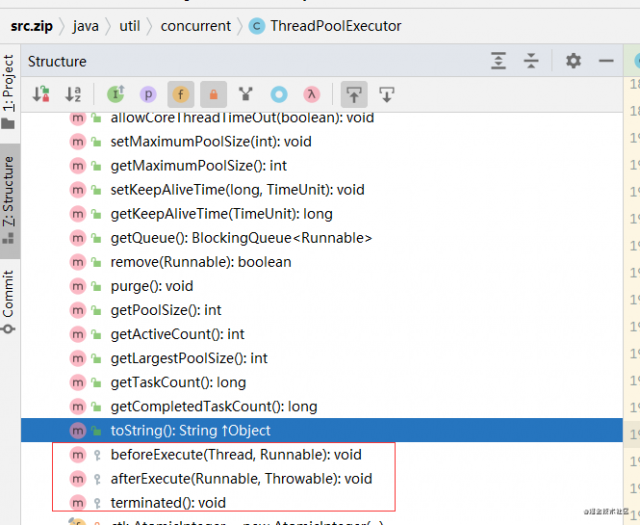一、扩展ThreadPoolExecutor
1、扩展方法介绍

ThreadPoolExecutor是可以扩展的,它内部提供了几个可以在子类中改写的方法(红框内)。JDK内的注解上说,这些方法可以用以添加日志,计时、监视或进行统计信息的收集。是不是感觉很熟悉?有没有一种spring aop中 @Around @Before @After三个注解的既视感?
我们来对比一下
其实他们的效果是一样的,只是一个在线程池里,一个在拦截器中。
对于ThreadPoolExecutor中的这些方法,有这样的一些特点:
1、无论任务时从run中正常返回,还是抛出一个异常而返回,afterExecute都会被调用(但是如果任务在完成后带有一个Error,那么就不会调用afterExecute)
2、同时,如果beforeExecute抛出一个RuntimeExecption,那么任务将不会被执行,连带afterExecute也不会被调用了。
3、在线程池完成关闭操作时会调用terminated,类似于try-catch中的finally操作一样。terminated可以用来释放Executor在其生命周期里分配的各种资源,此外也可以用来执行发送通知、记录日志亦或是收集finalize统计信息等操作。
2、扩展方法实现
我们先构建一个自定义的线程池,它通过扩展方法来添加日志记录和统计信息的收集。为了测量任务的运行时间,beforeExecute必须记录开始时间并把它保存到一个afterExecute可以访问的地方,于是用ThreadLocal来存储变量,用afterExecute来读取,并通过terminated来输出平均任务和日志消息。
public class WeedThreadPool extends ThreadPoolExecutor {
private final ThreadLocal<Long> startTime =new ThreadLocal<>();
private final Logger log =Logger.getLogger("WeedThreadPool");
//统计执行次数
private final AtomicLong numTasks =new AtomicLong();
//统计总执行时间
private final AtomicLong totalTime =new AtomicLong();
/**
* 这里是实现线程池的构造方法,我随便选了一个,大家可以根据自己的需求找到合适的构造方法
*/
public WeedThreadPool(int corePoolSize, int maximumPoolSize, long keepAliveTime, TimeUnit unit, BlockingQueue<Runnable> workQueue) {
super(corePoolSize, maximumPoolSize, keepAliveTime, unit, workQueue);
}
//线程执行之前调用
protected void beforeExecute(Thread t,Runnable r){
super.beforeExecute(t,r);
System.out.println(String.format("Thread %s:start %s",t,r));
//因为currentTimeMillis返回的是ms,而众所周知ms是很难产生差异的,所以换成了nanoTime用ns来展示
startTime.set(System.nanoTime());
}
//线程执行之后调用
protected void afterExecute(Runnable r,Throwable t){
try {
Long endTime =System.nanoTime();
Long taskTime =endTime-startTime.get();
numTasks.incrementAndGet();
totalTime.addAndGet(taskTime);
System.out.println(String.format("Thread %s:end %s, time=%dns",Thread.currentThread(),r,taskTime));
}finally {
super.afterExecute(r,t);
}
}
//线程池退出时候调用
protected void terminated(){
try{
System.out.println(String.format("Terminated: avg time =%dns, ",totalTime.get()/numTasks.get()));
}finally {
super.terminated();
}
}
}
测试案例:
public class WeedThreadTest {
BlockingQueue<Runnable> taskQueue;
final static WeedThreadPool weedThreadPool =new WeedThreadPool(3,10,1, TimeUnit.SECONDS,new ArrayBlockingQueue<Runnable>(100));
public static void main(String[] args) throws InterruptedException {
for(int i=0;i<3;i++) {
weedThreadPool.execute(WeedThreadTest::run);
}
Thread.sleep(2000L);
weedThreadPool.shutdown();
}
private static void run() {
System.out.println("thread id is: " + Thread.currentThread().getId());
try {
Thread.sleep(1024L);
} catch (InterruptedException e) {
e.printStackTrace();
}
}
}
3、使用场景
用到这些方法的地方其实和用到Spring AOP中一些场景比较相似,主要在记录跟踪、优化等方面可以使用,如日志记录和统计信息的收集、测量任务的运行时间,以及一些任务完成之后发送通知、邮件、信息之类的。
二、CompletionService操作异步任务
1、异步方法的原理
如果我们意外收获了一大批待执行的任务(举个例子,比如去调用各大旅游软件的出行机票信息),为了提高任务的执行效率,我们可以使用线程池submit异步计算任务,通过调用Future接口实现类的get方法获取结果。
虽然使用了线程池会提高执行效率,但是调用Future接口实现类的get方法是阻塞的,也就是和当前这个Future关联的任务全部执行完成的时候,get方法才返回结果,如果当前任务没有执行完成,而有其它Future关联的任务已经完成了,就会白白浪费很多等待的时间。
所以,有没有这样一个方法,遍历的时候谁先执行完成就先获取哪个结果?
没错,我们的ExecutorCompletionService就可以实现这样的效果,它的内部有一个先进先出的阻塞队列,用于保存已经执行完成的Future,通过调用它的take方法或poll方法可以获取到一个已经执行完成的Future,进而通过调用Future接口实现类的get方法获取最终的结果。
逻辑图如下:
ExecutorCompletionService实现了CompletionService接口,在CompletionService接口中定义了如下这些方法:
Future
Future
Future
Future
Future
2、异步方法的实现
public class WeedExecutorServiceDemo {
/**
* 继续用之前建好的线程池,只是调整一下池大小
*/
BlockingQueue<Runnable> taskQueue;
final static WeedThreadPool weedThreadPool = new WeedThreadPool(1, 5, 1, TimeUnit.SECONDS, new ArrayBlockingQueue<Runnable>(100));
public static Random r = new Random();
public static void main(String[] args) throws InterruptedException, ExecutionException {
CompletionService<Integer> cs = new ExecutorCompletionService<Integer>(weedThreadPool);
for (int i = 0; i < 3; i++) {
cs.submit(() -> {
//获取计算任务
int init = 0;
for (int j = 0; j < 100; j++) {
init += r.nextInt();
}
Thread.sleep(1000L);
return Integer.valueOf(init);
});
}
weedThreadPool.shutdown();
/**
* 通过take方法获取,阻塞,直到有任务完成
*/
for (int i = 0; i < 3; i++) {
Future<Integer> future = cs.take();
if (future != null) {
System.out.println(future.get());
}
}
}
}
调用结果如下
我们也可以通过poll方法来获取。
/**
* 通过poll方法获取
*/
for (int i = 0; i < 3; i++) {
System.out.println(cs.poll(1200L,TimeUnit.MILLISECONDS).get());
}
结果自然是一样的
如果把阻塞时间改小一些,目前的代码就会出问题
/**
* 通过poll方法获取
*/
for (int i = 0; i < 3; i++) {
System.out.println(cs.poll(800L,TimeUnit.MILLISECONDS).get());
}
同样的,poll方法也可以用来打断超时执行的业务,比如在poll超时的情况下,直接调用线程池的shutdownNow(),残暴地关闭整个线程池。
for (int i = 0; i < 3; i++) {
Future<Integer> poll = cs.poll(800L, TimeUnit.MILLISECONDS);
if (poll==null){
System.out.println("执行结束");
weedThreadPool.shutdownNow();
}
}
3、使用场景
选择怎么样的方法来异步执行任务,什么样的方式来接收任务,也是需要根据实际情况来考虑的。
1.、需要批量提交异步任务的时候建议你使用 CompletionService。CompletionService 将线程池 Executor 和阻塞队列 BlockingQueue 的功能融合在了一起,能够让批量异步任务的管理更简单。
2、让异步任务的执行结果有序化。先执行完的先进入阻塞队列,利用这个特性,你可以轻松实现后续处理的有序性,避免无谓的等待。
3、线程池隔离。CompletionService支持创建知己的线程池,这种隔离性能避免几个特别耗时的任务拖垮整个应用的风险。
有需要的同学可以加我的公众号,以后的最新的文章第一时间都在里面,需要之前文章的思维导图也可以给我留言